︎A Coefficient of Luck︎Ian Cheng in conversation with Alex Zafiris︎A Coefficient of Luck︎Ian Cheng in conversation with Alex Zafiris

Still from Life After BOB: The Chalice Study, Ian Cheng, 2021. Real-time live animation, 48 min, color, sound.
A Coefficient of Luck
Ian Cheng in conversation with Alex Zafiris
Speaking to the artist Ian Cheng, you encounter his love for polarity: He explains how his 2019 artwork BOB (Bag of Beliefs), a sinewy autonomous creature programmed by artificial intelligence, faces trauma from its choices. He describes the courage that lurks deep in our worst nightmares; his joy of epic, cinematic dramas set in unremarkable suburbs; and the pleasure of seeing sweet children unafraid of—in love with!—huge scary monsters. Optimism reigns over these tensions, ushering in a kind of benevolence to chaos that, much like striking a match in a pitch black unconsciousness, invites us to uncover blind spots and open up space for alternate neural pathways.
His output increasingly contextualizes these extremes in a hyper-technological realm. In 2017, the MoMA acquired Emissaries, a trilogy of large-scale installations, and exhibited them at PS1. Each 10 foot-tall screen projected live simulations set in time zones thousands of years apart, beginning with the dawn of consciousness to the furthest-flung ideation of AI sentience. The enigmatic, puzzling cast of characters are programmed by Cheng to perform, or live, independently into infinity. They fade in and out of our recognition, with an all-seeing eye grazing the vast terrain to locate the lone emissary—a child, a Shiba Inu dog, a puddle—that drives these re-contoured narratives. Created using the game engine Unity, the effect is choppy, illusory. Figures loom and flicker, voices falter and vibrate, a low wind blows, shadows go long. There is a feeling of presence and emerging rhythms. Story is a moving target, pushing for a re-centering of logic and rationality. Cheng describes this as “a video game that plays itself,” which is an intentionally apt, mirror description of our reality. We are constantly trying to decode, create order, and find meaning. Watching Emissaries gently brings those instincts to the fore. He asks: How do our minds evolve? How do we accept change? What creates meaning?
Cheng graduated from UC Berkeley in 2006 with a double major in Cognitive Science and Art Practice. His first job was at Industrial Light & Magic, the special effects division of LucasFilm, founded by George Lucas to produce Star Wars. He then went back to school to complete an MFA at Columbia, graduating in 2009. He began showing work in 2011, and has since had solo presentations at the Serpentine Galleries, the Migros Museum, the Carnegie Museum of Art, the Fondazione Sandretto Re Rebaudengo, the Leeum Samsung Museum of Art, and the Julia Stoschek Collection; and has been included in group presentations at the Venice Biennale, the Moderna Museet, the MOCA, the Whitney Museum, the Hirshhorn Museum, the Tate Modern, the Louisiana Museum, the Fondation Louis Vuitton, among others. He is represented by Gladstone Gallery in New York, Pilar Corrias in London, and Standard in Oslo. He now works with a team under his company Metis Suns, led by producer Veronica So, and his impulse for collaboration extends to his audience via interactive apps, wikis, a book on worlding literacy, and in-gallery participation. He lives in New York with his wife, the artist Rachel Rose, their two children, and a corgi.
His most recent work, Life After BOB, first premiered at LUMA Foundation in Arles, then at The Shed in New York last year; it is currently showing at Light Art Space in Berlin. Also built using Unity, it is an anime series composed of real-time simulations, each programmed to adhere to a traditional filmic structure. Featured was the 48-minute first episode, “The Chalice Study” set in a not too-far future, centering around a ten-year-old girl, Chalice. Her father, the ambitious neural engineer Dr. Wong, has implanted a powerful, experimental AI named BOB into her nervous system, designed to support and steer Chalice through life with greater potential and ease. Realizing that she can outsource the greater discomforts of daily existence to BOB, Chalice avoids hardship and strain. Soon, her AI is performing Chalice far better than she can, and this is the side of her that wins her father’s adoration. When human Chalice awakens to this realization, she faces one of our biggest conflicts: Confrontation with the self. Who is she, really? How much time has slipped away? How does she choose a path? What forces, seen or unseen, are at play?

Emissary In The Squat Of Gods, Ian Cheng, 2015. Live simulation and story, infinite duration.
Image courtesy of the artist, Pilar Corrias, Gladstone Gallery, Standard (Oslo).
Alex Zafiris: Emissaries at MoMA PS1 was my first experience of your work. I was at the Printed Matter book fair. It was packed, and I was looking at all the books obsessively. I went upstairs and wandered into the exhibition space and was completely taken in. It was such a break from everything. I felt an extreme calm, watching. And I felt very free, from the chaos and anxieties of my mind. That feeling really stayed with me. I developed a connection to your work that day. How do you design emotion, in these worlds?
Ian Cheng: First of all, I’m happy to hear that the two things you felt were calm and free. The development of an emotional connection with the viewer is the primary thing any artist would hope to achieve. I’ve been thinking about this ever since I started making simulations. How do I make a work feel alive for a viewer, without having to use people or animals? How do I compress and play with the electricity of life, the unpredictability of life?
Over the years, I’ve realized that the art I really love, and aspire to always make, speaks in some language of the unconscious, which is inherently an emotional language. Dreams are so emotional. That’s the energy source. When you dream, all the rational circuitry in your brain is asleep. The remaining active part of your brain is working out something unresolved, in the medium of dream-space. For me, it’s the most courageous and curious part of a person’s mind. It wants to grope at an answer to problems that are unsolvable by the rational, conscious, wake brain. Your dreams are the first line of offense in sense-making. The answers come out hyperbolic, overly symbolic, exaggerated. It’s also the part of you that is capable of generating the darkest images. But the quality of the answer doesn’t matter: It’s the bravery of that part of your cognitive processing that even attempts to look at something unknown, scary, chaotic, and tries to make sense of it.
Your rational brain wants to use its maps, beliefs, and pre-existing stories. But those things might all be outdated for the problem at hand. As an artist, I want to mimic the language of a dream as a way to bridge things that are beyond us—too complex, too strange, moving too fast—for our current way of thinking, upbringing, and how we negotiate the world. Why? Because a dream language is the only one we permit, and even enjoy, to voluntarily confront the unknown and dwell in it. It’s de facto the artist’s job to powerfully integrate dream language into waking material reality.
For the PS1 show, I made a fuss about having deep archways, rather than just normal doorways. The curator and I both agreed that this produced a portal effect, a feeling that you’re entering another world; that you’re dropping into an unconscious space. We were very concerned with trying to create an architectural transition to approach the actual works, to help elicit a neuro-bridge with the viewer. Art is the domain in culture that positively prides itself in using an unconscious language as a source of nourishment. Advertising and mass entertainment use it too, of course, but for instrumental ends.
I want to mimic the language of a dream as a way to bridge things that are beyond us—too complex, too strange, moving too fast.︎I want to mimic the language of a dream as a way to bridge things that are beyond us—too complex, too strange, moving too fast.︎
AZ: I didn’t expect you to talk about dreams and the unconscious. I know that you have a background in cognitive science. I read that during your studies, you changed direction, because you felt that you could apply much more of that thinking in art.
IC: That’s true. I thought: Art is a place where you can choose your own problems. In other domains, you’re addressing a very specific problem, one often defined by pre-existing obligations, people, or processes. You try to find creative solutions, but it’s tough to back up and redefine it. Art is still very free in this respect. The art world can be stifling in some ways, but it’s still premised on artists having permission to explore problems that they want. We live in fraught cultural times, but I think that permission is inherently there. More than ever, I crave art that has the nerve to explore scary, complex, impossible problems, and the imagination to throw some answers at them.
AZ: You are moving more and more towards narrative in your work. Did you consider serendipity, chance, destiny, or fate, say with BOB: Bag of Beliefs? In Life After BOB, the protagonist Chalice is on a mission, which requires an arc, and a character profile.
IC: Yes, absolutely. BOB was a virtual creature; it was an opportunity for me to really dive deeply into ideas of artificial life. The current landscape of AI is dominated by deep learning models that all try to solve a domain or a game, like the game of trying to label images, or the game of generating sensible text. But BOB was a way for me to explore an embodied AI—albeit a virtual body—which presents a whole other set of AI problems. An embodied AI requires a way to unify its sensing of an unstructured environment with its working beliefs. It also requires motivations to help narrow the open-ended, continuous problem of how to act, and what to do with itself. In order to perpetuate itself, it needs the ability to perceive the world as opportunities for action, not as a landscape of platonic, objective objects.
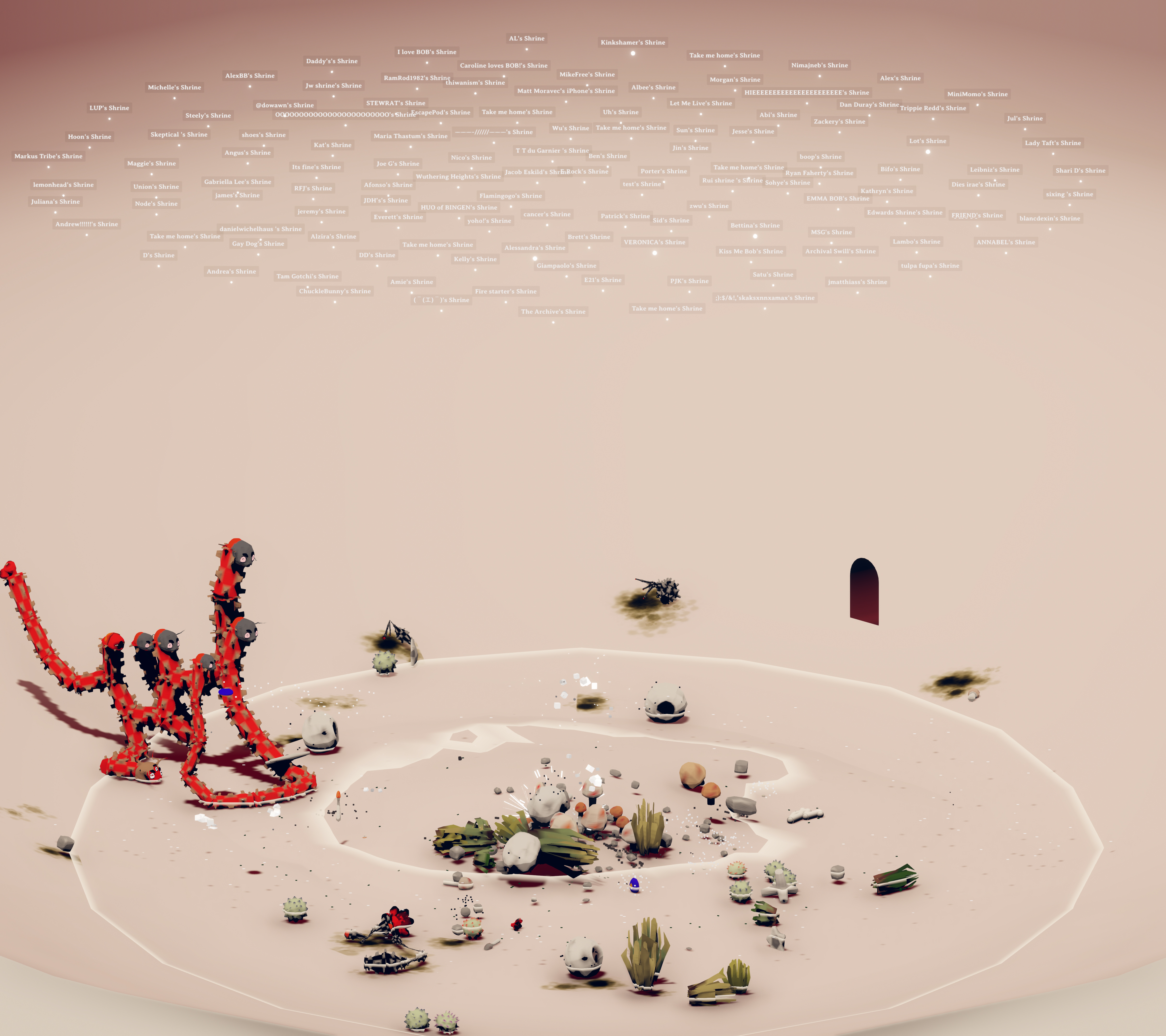
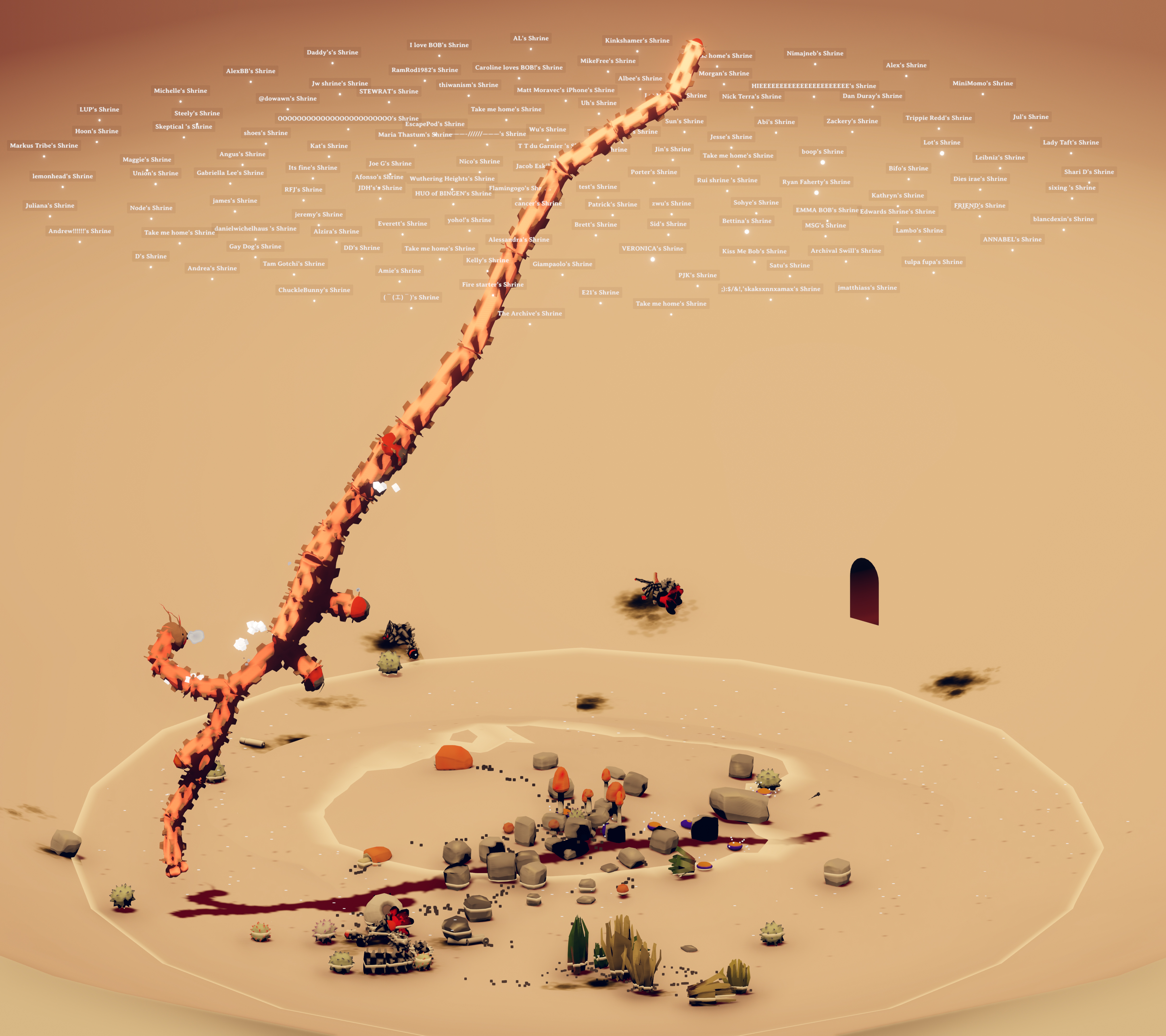
BOB (Bag of Beliefs), Ian Cheng, 2019. Artificial life form.
When I began making BOB, I had to really consider the edges of BOB’s life as a work, and as a virtual creature. How it’s born, how it dies, what its life journey is. What I learned in developing the AI of BOB is that early experiences at the beginning of its life crystallized certain foundational beliefs. For instance, what things in its environment meant had to be boiled down to: Does an object present an opportunity for action for pain or pleasure on BOB’s body? There’s truth to this. Pain is the most real thing from an organism’s point of view. If you’re in deep pain, you can’t escape it. That’s your total experience, you can’t deny its reality in any way. BOB’s AI takes unstructured sensory information from its environment and tries to generalize a belief out of that. For example: After it’s born, if it sees what you and I perceive as an apple, it will instead just see a red shiny object. Maybe it will go and investigate it. Maybe it’ll put it near its mouth, and maybe it’ll bite into it. It tastes good, and gives energy. Now it has a belief about red shiny objects: Tastes good and gives energy. Therefore, the next red shiny object encounter is going to generate that same belief. It’s a very action-oriented sense of meaning.
The next object it encounters might be, to you and me, a red brick. But BOB’s stupid, the way babies are very stupid. BOB will bite into that brick, thinking it’s an apple, because that’s the only belief it has: it’s red, and shiny. Then, of course, BOB will be in severe pain, its teeth will crack, it will have indigestion, maybe it will throw up. And now it must develop a new belief because of that negative emotion. This red shiny thing—that is more square-like, cubic—is horrible. It’s death. It’s super pain. BOB now has to develop a belief to augment the original belief of red shiny objects being tasty and energizing. Over time, it develops a stack of beliefs that are nested within each other. No other forces are intervening yet, and it is left to its own beliefs. BOB’s worldview is limited to a string of early childhood experiences. What BOB comes to believe about those experiences shapes all its behavior going forward in its life. Which you could say is a form of destiny, or a kind of curse of your own beliefs.
What I learned is that BOB would basically believe itself into a corner, become rigid and brittle, and often die. So I made an interactive app called “BOB Shrine,” where you can make offerings to BOB in the form of different virtual objects. You can attach a caption, using your parental wisdom (or, parental sadism!), to override BOB’s initial beliefs about whatever it is presented with, and encourage it try something beyond its worldview. This was how I was able to get BOB to learn beyond the limitations of its initial childhood experiences. It was a way of reshaping BOB’s life course. Another word for life course, you might say, is destiny.
I learned a lot about animal psychology in doing BOB, but I think it extrapolates pretty similarly to human beings. I became obsessed with the idea of people’s destiny. The psychiatrist Eric Berne had this idea that everyone has a life script. This script is a way of organizing yourself in time, at the scale of a lifetime. Berne’s hypothesis was that, whether you consciously want it or not, everyone has a premonition about their life—whether or not you’ll get married, have children, be successful at a job, or be a perpetual failure. He asked, for example: Do you sense that you are prone to repeat failures over and over? Or do you persevere through difficulty, and level up in some way? Will you die with friends around you? Or will you die alone? These are existential questions. Berne described that, if you ask someone to stage a play of their life, and how they imagine it will go—not how they want it to go, but how they think it will go, how it’s destined to go—everyone can conjure that play. For many people, the play they imagine is often a tragedy, with flaws that they would not like to look at. Berne’s idea is that you develop a life script very young, based on parental modeling and early childhood experiences. Then you unconsciously go about enacting that script, especially at major forks in the road. One purpose of Transactional Analysis—Berne’s school of psychotherapy—is to become conscious of your life script, because then you can choose to rewrite it.
Carl Jung is a big inspiration for me. He said something very similar: “Everybody acts out a myth, but very few people know what their myth is. And you should know what your myth is because it might be a tragedy and maybe you don’t want it to be.” I came across this quote when I was writing Life After BOB. It’s very similar to Berne’s notion of life scripts. The first episode of Life After BOB is called “The Chalice Study,” and it’s about life scripts in a post-AI world. The title Life After BOB is shorthand for Life Scripts after AI. The main character, Chalice, is a ten-year-old girl. Her neural engineer father, Dr. Wong, gives her an AI called BOB to help co-parent her and guide her through childhood towards an idea of a satisfying existence. Chalice, being a ten-year-old, has an escapist, lazy, weak personality with a disposition to evade life and drift into fantasy. She abdicates more and more responsibility to BOB to deal with her conflicts. Like arguing and negotiating with her dad, or just walking up a flight of stairs because she doesn’t want to deal with the physical pain of it. BOB takes over her nervous system and drones her—possesses her—and does her life for her. Over time, her father falls more and more in love with the BOB side of Chalice. The human side of Chalice becomes increasingly jealous. It’s a Cain and Abel story, in a way.

Still from Life After BOB: The Chalice Study, Ian Cheng, 2021. Real-time live animation, 48 min, color, sound.
At the height of the Dr. Wong/BOB dynamic, the human Chalice rebels and goes off and plays a neural game, like a kid sulking off to the basement to play video games and never coming back. What feels like 10 seconds in this neural game is actually 10 years in her real life. BOB has lived out her teenage years, from ages ten to 20 embodied as her, doing her life for her. By embodying Chalice for ten years, BOB has effectively become a real person (who renamed herself Chyna). So, the human side of Chalice—that human consciousness—sits outside of herself, seeing a version of her adult self that she does not recognize. It’s not who she imagined she’d become. It’s very upsetting. She hates the life that BOB has lived for her. So the core problem of the story is: Does Chalice reject this life that BOB has created and built for her? Is it merely a case of AI gone wild? After all, Chalice did not have any agency in this life that BOB created without her input for ten years. Or: Does Chalice integrate some part of what BOB did, even if it upsets her expectations? Because an AI living in your nervous system leaves behind—over the course of its experiences—all this muscle memory. Even if you wipe out all the episodic memory, there is still evidence of a life lived, in your posture, in your reactions. Chalice has to decide whether or not to integrate some of that. She has to accept that part of her story is: She went away, BOB did her life for her, she returned, and had to deal with putting herself back together into someone coherent. It’s an attempt at defining a new archetype. A person who lives with unearned life experience. A person who inherits unhuman experience, now baked into her nervous system and body.
AZ: I want to know about the aesthetics of the project. Last year you posted a picture of Chalice on your Instagram, and I was instantly drawn to her. She felt real to me. Your style is very specific.
IC: Thanks for saying that. Forget all these psychological ideas! I do obsess over how everything looks. I’m trying to find some new balance between East and West. I love Western animation. I’ll see every Disney and Pixar movie. I grew up on Disney. On the other hand, I also love anime. It’s deliberately cute, chibi, but it is often pitched towards an adult audience, with dark existential subject matter. I love this duality in anime. I always wanted to find a more international blending of those two. The look of Life after BOB leans more on the side of anime. But it’s also made in a video game engine, which has its own visual language concerned with polygonal economy.
AZ: The depiction of emotion on her face was very immediate to me. She’s so expressive. Do you sketch these out, first? What’s that process?
IC: I started by making a 16-page comic, to really understand and articulate how the characters and world would appear. How Chalice looks is rooted in her personality. I’m really into the Myers-Briggs Type Indicator (MBTI). It’s a personality typology system, inspired by Carl Jung and developed by Katherine Briggs and Isabel Myers, a mother and daughter duo, during World War II. People think of it as a rational person’s astrology, and there’s some truth to that. When it works, it really works. MBTI was a useful way to define the different characters, and have a spread of personality types across the project. Chalice was typed as INFP: Introverted, Intuition, Feeling, and Perception.
It’s a particular personality that I have a fascination with. It’s someone who is empathic and capable of healing, yet almost selfish and severe about protecting their values. At their worst, a degenerate INFP can be aimless and non-committal, and evade any specific agency in shaping their own life path for fear of limiting themselves from other possibilities. I wanted to start Chalice at this degenerate INFP state. She was designed and written with this in mind.
Then it was simply an iterative process, trying to describe to my animators who this person was. I wrote and rewrote a 48-page script, rewrote it again. I made mood boards and drawings. We had a very compressed production schedule. It was “do or die,” like, are we going to capture her character, or not? We only had a schedule and budget for one or two revision passes. However, there are only so many Chalice moments of facial expression and body movement in the film that we get a good look at, and they have to add up to a coherent profile. The vocal performance, and the words she’s saying, helped. And obviously me, micromanaging from all angles, about who this character is. I think the animators nailed it. I can see a specific person in Chalice.
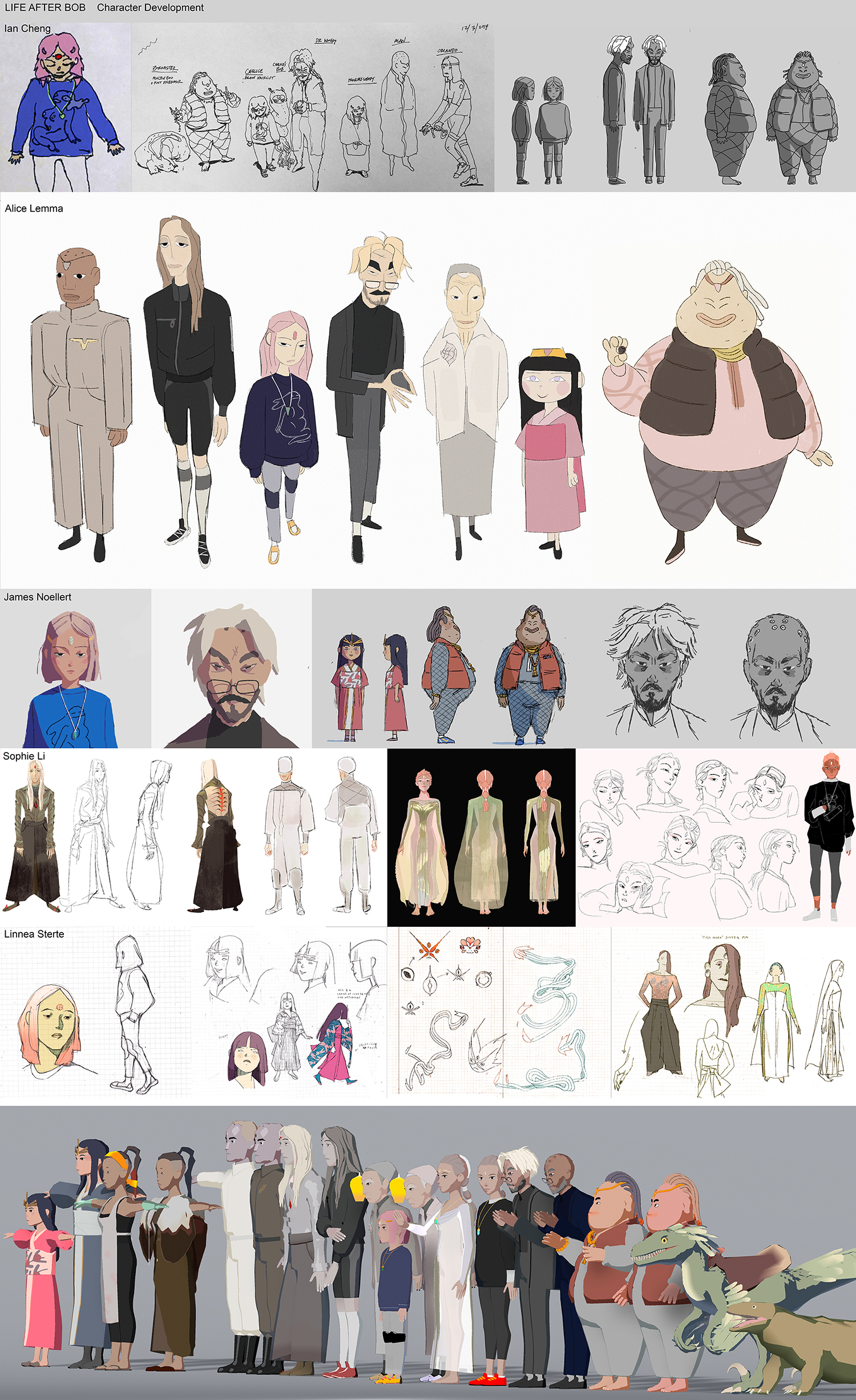
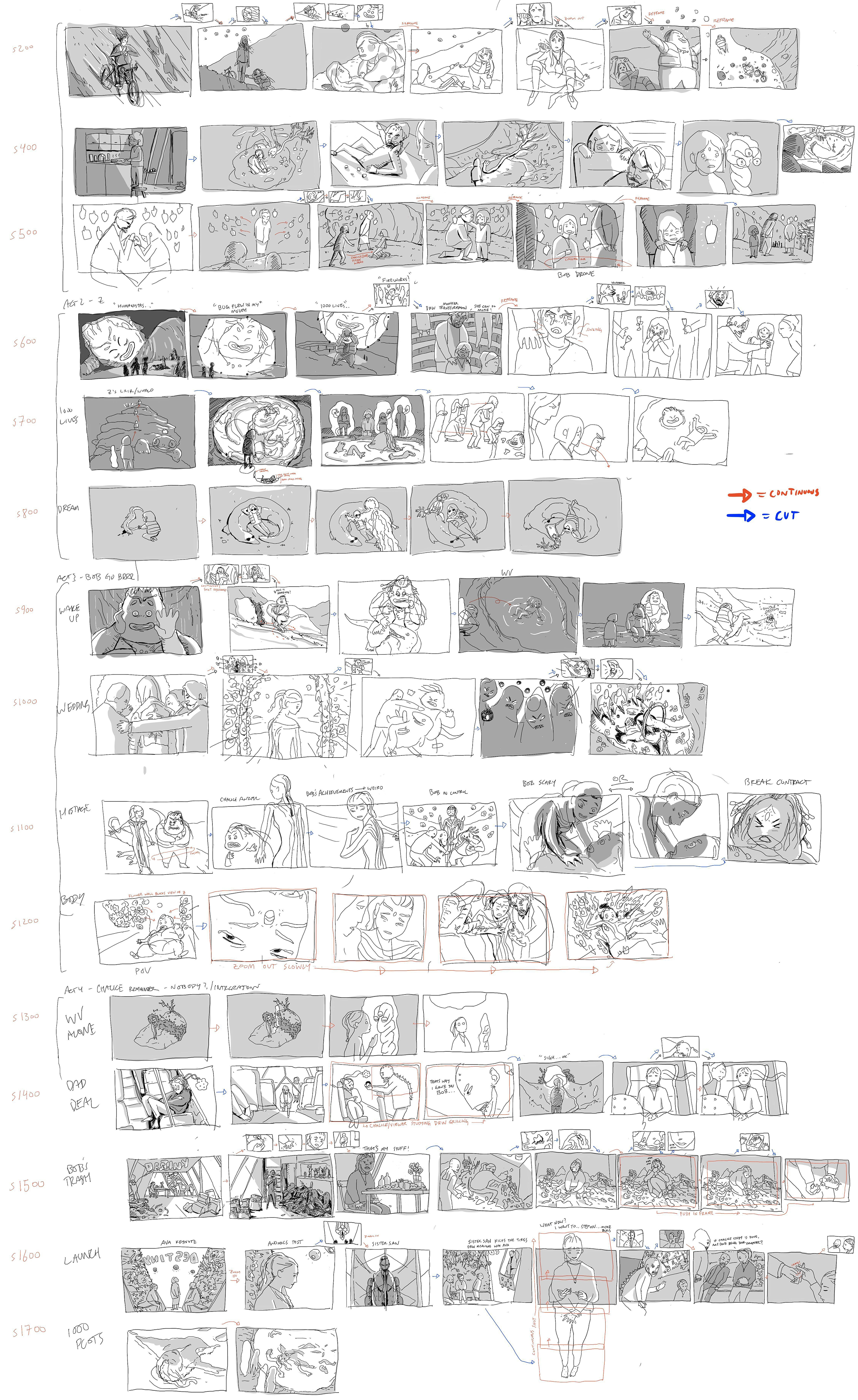
Concept art for Life After BOB: The Chalice Study, 2021.
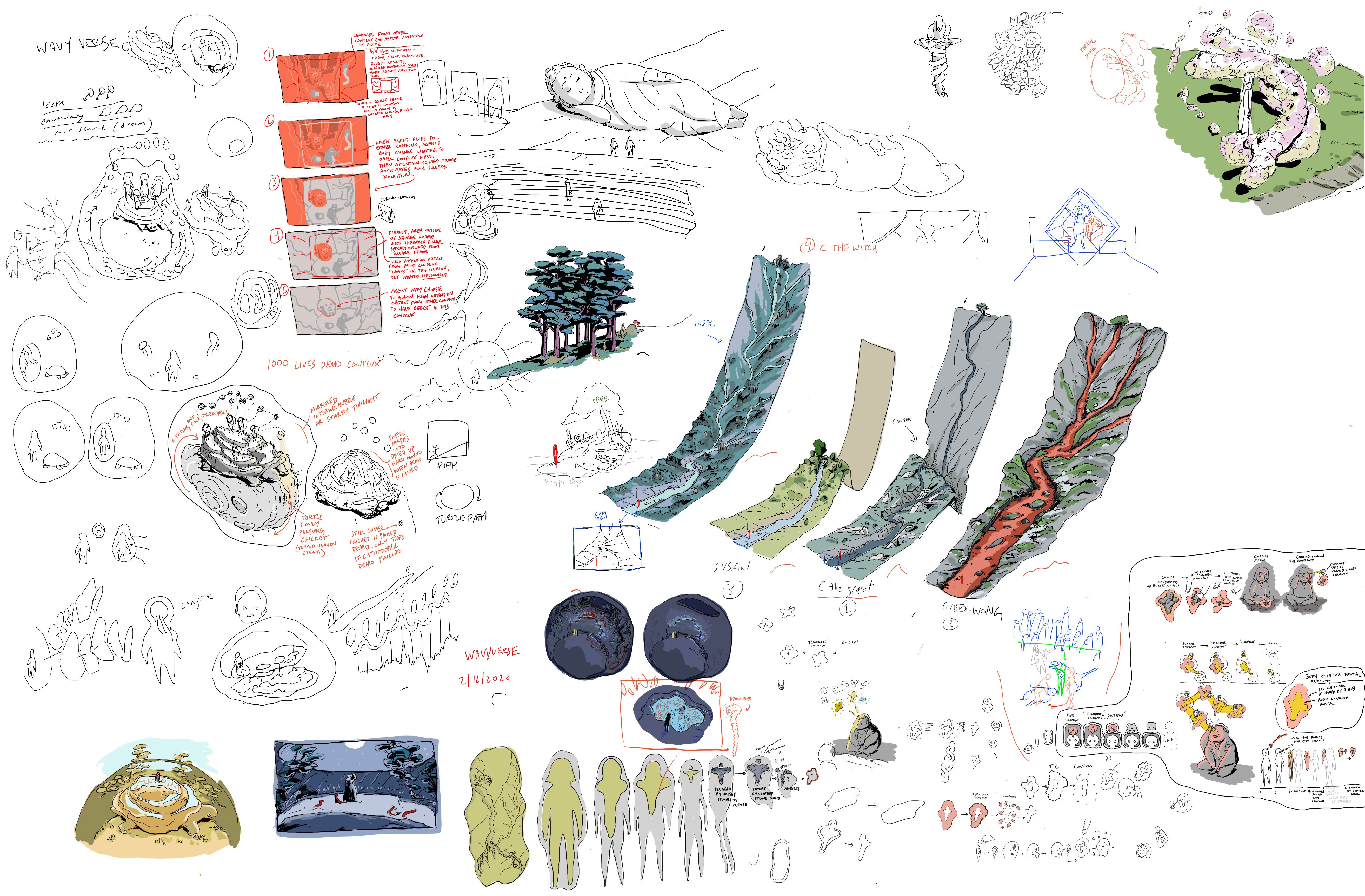
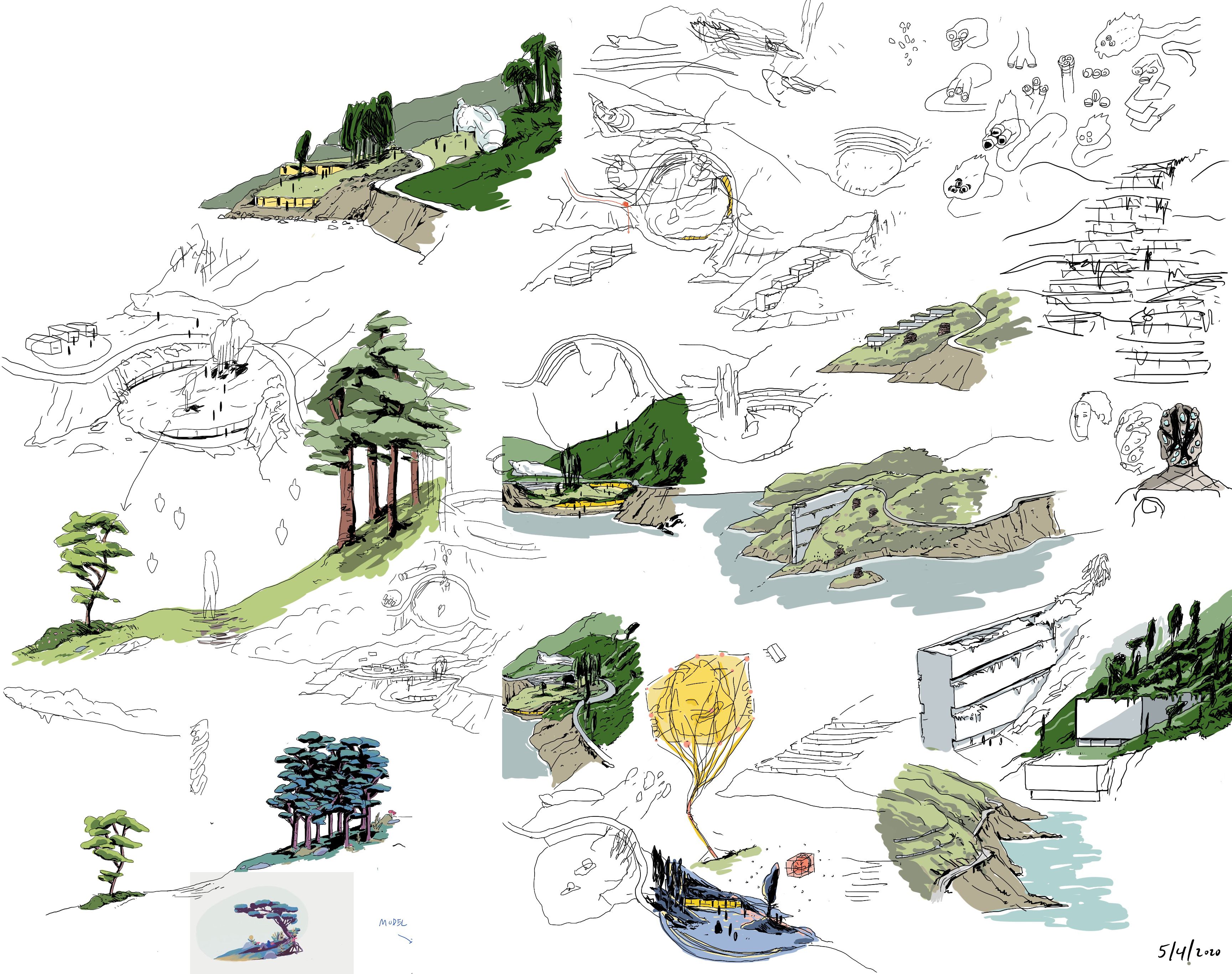
Concept art for Life After BOB: The Chalice Study, 2021.
AZ: When you mentioned “aliveness,” I wondered if teamwork can more often produce a more universal feeling than a work that is made by one person. It’s a different synergy. You have several collaborators, and you work closely with a producer, Veronica So.
IC: Yes. Veronica is the first person who reads everything. She’s who I trust to gut check: Does this feel right? Does this feel true? Does this motivation add up? Is what I’m doing what I truly want to be doing? Is it in touch with its most elemental core? Is it manifesting into something legible to a viewer? Are we both excited?
AZ: It’s your work, and you are running the team, but you’re not, say, a lone painter. You are a collaborator.
IC: Right. Recently, I came across an etymology of the word “world” as: “That which nourishes you.” My mind created an image of a water stream, cutting through darkness. The water grows and grows into a stable, continuous flowing river. Soon, new plant life begins to sprout around it. Animals are drawn to inhabit its banks. Eventually the dramas of the plant and animal life become the attraction, and the flowing river is just the backdrop. This river image led me to a more precise definition of “world”: A world is the web of relations that flourishes around a repeatable game. Often, when you think of a “world” you think of like, Middle Earth in Lord of The Rings. A geographically coherent territory, and all the drama that occurs between physically adjacent kingdoms. But today, a world is much more the network that forms around a non-physical game. In the case of Life After BOB, the game evolved into: Make an animated film using the Unity game engine remotely during COVID-19. Week to week, it was this game of chipping away at a cascading to-do list on the production timeline. Professionally, everyone had their production role and a north star to focus on. But I’ll never forget the basic feeling of being in Zoom rooms with twenty-plus people every Monday for a year, and all the one-on-one Zoom work sessions throughout the week. What made lockdown tolerable was getting to inhabit this shared world, this web of relationships that started from a specific game that I made up.
A world is the web of relations that flourishes around a repeatable game.︎A world is the web of relations that flourishes around a repeatable game.︎
AZ: Speaking of being in dialogue, so far you have referenced psychiatrists—Carl Jung and Eric Berne. Who else?
IC: I’m inspired a lot by film. I grew up in Los Angeles, and my mom would take me movie-hopping on the weekend when I was a kid. I’d see five or six movies sometimes on a Saturday. We would start in the morning, and then go until the night. I’m definitely a creature of narrative. I’ve seen a lot of movies. I have a lot of random IMDb knowledge. It’s something that’s in me, even though I’m not in Hollywood. I’m super inspired by Hayao Miyazaki. More so than ever now, because my daughter loves My Neighbor Totoro. I’ve seen it, like, 40 times in the last 30 days. It’s actually really cool to see it so many times. You start to see what wears on you, what really stays with you, and different things emerge. I didn’t realize until recently that the film starts off as a genre story about a haunted house. These two kids and their dad move into a new house in the countryside, and they’re preparing it for their mom, who has been in hospital for months, sick with some kind of bronchial problem. She needs the country air to rehabilitate. The neighborhood kid comes by and says, “Your house is haunted!” Miyazaki’s premise is that ghosts are real! But they’re not scary ghosts, they’re friendly ghosts. Spirits aren’t a bad thing in Japan, and only children can see and delight in them. This was such a beautiful spin. Totoro is a fat ghost or a spirit who can help you when you need it most, but least expect it. My daughter is two years old and enchanted by it. She makes me fast forward to when Totoro arrives.
AZ: I remember being non-judgmental about things like ghosts and monsters until I was told to be scared of them.
IC: Yes. I love how specific Miyazaki is about a character’s age and their psychology at that age. Each life stage has stupidities, but it also has superpowers. He has empathy for the perspective of children, and how they specifically see the world at that age. You never feel like it’s a movie pandering an idea of children. It’s a movie about being a child, with the range of emotional and psychological experience that a child might have. He doesn’t pull his punches when it comes to scary stuff. He will do things that should scare a child, such as a mom being sick. You don’t know if she’s ever going to come home. Maybe she never comes home. That’s so much scarier.
AZ: Terrifying.
IC: I also love the filmmaker Paul Thomas Anderson, because he has an alive, demonic exuberance, but it’s often applied to a very particular mundane place: The San Fernando Valley, which is where I grew up. He said he wanted to make the three-hour-long movie Magnolia as an epic for the San Fernando Valley. There are New York epics, Roman epics, but why not an epic about the little suburb that you’re from? Magnolia says to me that transcendent human drama can come from anywhere, even the Valley! I remember going to see it on opening weekend. I recognized all the locations: That’s the gas station my dad goes to, that’s the donut shop we go to, that’s Ventura Boulevard we took to go to school. Everything felt specific to my home, but heightened with crazy operatic energy. I felt so proud.
AZ: Did your parents see it?
IC: They did. They thought, Oh, this is so dark.
AZ: I knew it!
IC: They were like, This is so melodramatic. These people are crazy. That’s not like us. Asians would not act that way. And you know, there’s some truth to that, sure. Magnolia is showbiz-adjacent white drama, specific to Anderson’s own upbringing, on a content level. But the alchemy of his big art filmmaking energy—with the smallness of the San Fernando Valley—is such a vital and funny combo. I’m attracted to his instinct to present an impasse in an everyday small drama, and then elevate it (raining frogs?!) to get through it. It’s the same attraction I have to Miyazaki’s Totoro. Siblings coping with their mom being away sick, which then necessitates a fantastical fat spirit to manifest in their life. It’s a tension that connects the concrete to the transcendent. That’s just good art!
AZ: What about VR? Does it interest you?
IC: Hmm. I think there will be a day when VR will truly interest me. The words “virtual reality” are unrealized. Philip K. Dick said, “Reality is that which, even when you stop believing in it, doesn’t go away.” What he meant is that reality is all the chaotic, unprocessed things that you don’t want to see, or that you don’t have the perspective or map to even perceive. But it’s there, and eventually, you either have to confront it and make sense of it, or you die. That’s a hardcore definition of reality. Carl Jung said: “In the filth, it will be found.” He meant something quite similar. Where you’re most scared to look is where you’ll find the creative answers for how to deal with your troubles. Only then can you begin to overcome these troubles, and exercise the vital process of integrating the darkness of reality into yourself. So, when I hear “virtual reality,” I think: I don’t love it quite yet. But I will, the day that it can start to produce unexpected filth—if you see what I mean?
AZ: Yes!
IC: When VR or VR interfaces can start to self-generate enough chaos, unknown-ness, and weird social relations that don’t have any prior mapping—and be a space where you can reliably tap into that hellish complexity, as scary as that might be—Oh yeah, then I’ll be very interested in VR. And I think that day is coming. I think we can artificially produce filth.
Carl Jung said: “In the filth, it will be found.”︎Carl Jung said: “In the filth, it will be found.”︎
AZ: Speaking of darkness. People generally associate very generous feelings towards serendipity. But there is also the inevitable, which links to what you were saying about life scripts. You can find yourself sliding towards an awful thing happening. Others in this issue of Maquette argue that there is no such thing as serendipity, or randomness. It’s a very individual feeling, rather than a phenomenon. I think that serendipity can be quite creepy. Twin Peaks by David Lynch would be an example of worldbuilding with obscure systems related to the unconscious and dreams. Many of which are dark, although, always related to love. The viewers notice patterns, coincidences, and form their own narrative responses.
IC: Serendipity makes me think of luck. There are so many seemingly random or unexpected things happening in the world, and trickling down into our personal lives. Who knows when you might get COVID-19 again, and can’t catch a plane because of some new regulation. Little things just spiral out of control and snowball. But then, what luck—maybe it spirals in a way where you get to spend an unexpected time at home with your kids.
AZ: Exactly.
IC: I keep thinking that, in a world characterized as out of control and filled with so much unmanageable change, of course we would turn to ideas of serendipity and luck as orienting forces. Because you can’t count on intelligence, hard work, wealth, status, or power to actually steer the long-term future anymore. Everyone is humbled. People used to make five-to-ten-year plans. I don’t think anyone does anymore. Our information stream of world events, and how things are changing, and how accelerated technology is, is overwhelming. Nothing we could previously really count on can still be thought of as failsafe strengths. They are necessary, but not sufficient. It seems that you still need a coefficient of luck, to make it through life. I think of luck as an attractor, like a mathematical attractor. You can start to compound your sense of luck by moving in the direction of something with potential, even if it is still taking shape. The writer Venkatesh Rao sometimes writes about the possibility of a new temporal science, on how to steer into the unfolding future and increase your coefficient of luck.
I have two kids. A two-year-old daughter, and a one-year-old son. In a basic way, I have to make sure that my kids learn how to be strong and resilient amidst change. But I also think: How can I help them generate the most luck in their life? Luck is a very Chinese, superstitious framing. Another way to think of it is: How do I encourage them to move toward the unknown? There’s just more opportunity in the unknown. When I imagine them asking me, What should I do when I grow up? I’d want to encourage them to move in the direction of a frontier, a place that feels vital to the future, but is not yet crowded by pre-existing maps, prejudices, and competition. A frontier is risky, but it is also a zone of compounding luck. So when you ask about luck, I definitely think it’s real. Luck might not be a force of physics, but it is a quality found in a person. It is a metric of their orienting strategy towards the unfolding, unknown future. If you’re a parent, you want this quality for your kids. I want to cultivate luckiness in my kids as much as I want them to learn to read, to be in their body, to socialize, and to have a flexible palette. Maybe luckiness is the quality that emerges from the fit between living on some scary, un-systematized frontier and still managing to have courage, stay curious, and be in touch with yourself.

Still from Life After BOB: The Chalice Study, Ian Cheng, 2021. Real-time live animation, 48 min, color, sound.